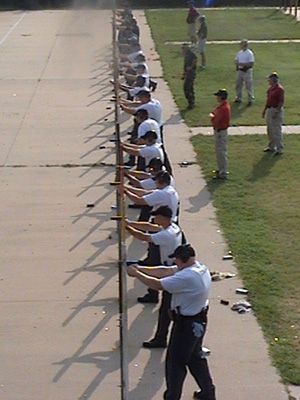Modern handguns for law enforcement have come a long way in the past 30 years. Starting in the mid- to late 1970s, semi-automatic handguns began to replace revolvers for police use. Over the years, many different makes and models — featuring different grips, ergonomics, calibers and other factors — began to enter the marketplace and compete for departmental contracts.
 |
Rigorous testing and evaluation by firearms trainers led to improved design and function for the various brands. These days it’s rare to see a bad handgun from most of the companies that manufacture the most commonly used law enforcement firearms.
Some, like Richard Fairburn, who wrote an excellent article for his Police1 column, suggest that there is really little value in testing and evaluating law enforcement firearms. The argument is that you would be hard pressed to find any that aren’t high quality or that wouldn’t meet your needs.
I appreciate Fairburn and I value his input as a straight shooter who has enough history to know how far we have come in this field to get where we are today. However, experts will disagree from time to time, and this is one of those instances.
I also have a lot of history with law enforcement firearms, dating back to 1980. I have been shooting since I was 5 years old. I have shot every law enforcement firearm in common use today and many others that could be considered more exotic. They all have one thing in common: They are made of metal, and some are made of a combination of plastic and metal. After that, there is quite a bit of variation to be found in terms of materials used, ergonomics, handling qualities, sights, calibers and other elements.
While there may be no bad duty pistols on the market, there certainly are those that stand out in terms of the above-mentioned variations, and that will prove to be better suited for the missions you have in mind.
In today’s hyperactive marketplace, where we are flooded with comments, evaluations, forums, sales pitches and the like, it becomes increasingly difficult to separate the wheat from the chaff. Gun tests tell only part of the tale. You may not know the tester personally, the affiliations of the tester or even most of the tester’s background in many cases.
And this leads us to the main point: the human element of testing. Think of when you are driving in a car and you have a passenger in the seat next to you. He tells you that traffic is clear from his side. You still look to make sure. Here, emotions will play as much a role as logic. Seeing and evaluating for yourself is part of the adult psyche and should not be discounted.
I also believe that due diligence requires independent verification of test results to avoid unintentional bias. As Fairburn points out, the individual bias of the tester may have a lot to do with the weapon selected. I have seen large agencies select a weapon because they could piggyback on an existing contract rather than choose a superior weapon. This was done for expediency or individual gain, and many times it was against the advice of senior firearms trainers who conducted the testing. Going with another agency’s selection without doing your own homework may lead you into the same mistakes they made in the process.
Bias plays a strong role when it comes to selection. Some have a history with a particular brand or type of firearm, or they subscribe to a set of beliefs about something, right or wrong, and it influences their choices.
This can be anything from believing that the cocked-and-locked position of the 1911 is more dangerous than a double-action auto to the belief that revolvers are more reliable than modern semiautos. Yet these same people will allow an AR-15, with cocked-and-locked hammer very similar to the 1911, into their agency. Doesn’t make a lot of sense, but it happens nonetheless.
You may fall into a different camp when it comes to firearms or ammunition selection. You may happen to like the way a particular gun feels in your hand compared with another brand. Again, this is the human element manifesting itself.
I will give you a personal example relating to ammunition selection and the human element. Going back to the 1986 Miami Shootout, where two FBI agents lost their lives, and the lessons learned from it, I believe it was Urey Patrick who stated that 16-18 inches was a recommended depth for bullet penetration, and 12 inches was the minimum. Everybody jumped on the 12-inch minimum, and manufacturers gave them what they asked for.
I happen to agree wholeheartedly with the 16-18-inch figure, with adequate bullet diameter and expansion, for my own all-around personal use, due to my own testing on critters, clothing, windshields and car bodies, among other things.
This is one of the reasons I like the 230-grain .45-caliber ACP to interpersonally communicate my desire to stop someone from seriously hurting me or someone else. I have shot a lot of critters with a .45 ACP with different bullet types and velocities. Seeing is believing.
For other, more specialized missions, such as shooting on board an airplane or in heavily populated apartment complexes, I might choose a round that wouldn’t penetrate as much but has a lot of energy to expend — perhaps a 185-grain load in .45 ACP or a 155-grain .40 Smith & Wesson.
However, the point is that I can’t just go with my own preferences when I am involved in selecting a firearm for an agency. I have to identify my own biases and take steps to ensure that the process is fair and balanced. This is why I like to see more than a small selection committee in on the process.
Issues such as a realistic assessment of the primary mission, hand size, caliber and bullet type along with adequate testing on structures, gelatin and so on — and a lot of shooting by various individuals to get a perspective on the weapon — are things that should be done by the agency and not left to others to decide for them.
No matter how much you or I may like a particular round or firearm, we may find through our testing that some individuals in the department can’t deal with the weapon’s size or recoil. Does the brand you choose have firearms with different grip circumferences or a grip that will fit almost everyone? If you choose a hotter round, can everyone shoot well with it, or do you see problems with flinching start to arise?
Do you allow other brands into the department if your testing confirms that some people can simply shoot one brand better than the one you happen to like? Will you allow accessories that show a clear improvement over the stock firearm? Administrative concerns over ease of maintenance, ammunition requirements and just plain unwillingness to deal with more than one firearm can lead to an unbalanced selection.
Just because a majority of the market may have picked a particular firearm in the past is no reason not to exercise due diligence. Things are changing and evolving in the marketplace constantly, and we should do our own homework. Newer guns, such as the Springfield XD in .45 ACP, offer a far more ergonomic shooting package, in my opinion, than the current majority. Smith and Wesson, Ruger and others are also making inroads with newer designs, better triggers and excellent ergonomics.
The human element is why we need to test. We need to judge for ourselves — to kick around ideas, see what people in our agency and other agencies think. We need to let more people in on the process, let them give their input, and let them feel they are part of the process rather than a leaf in the wind, subject to forces beyond their control. This reinforces their confidence in the weapon that is selected.
That is why we test. We need to feel confident in what we have chosen. You can use the testing by others as a part of your evaluation process, but only by testing it yourself will you know for certain that it is right for you.


